The Western Trust Podiatry service provides specialist clinical services to those patients most at risk of foot health problems/conditions.
The Podiatry service provides specialist advice and treatment for high-risk patients suffering from complex nail and foot conditions. We hold outpatient clinics in GP practices and the main hospital sites.
Podiatry services are delivered by a skilled team of podiatrists and podiatry assistants. All our Podiatrists are registered with the Health and Care Professions Council and have completed a minimum of three years of accredited training at degree level or an equivalent qualification.
The service works closely with the Ulster University to support BSc (Hons) Podiatry students with work-based learning.
Referral to the Podiatry Service can be made via your GP or another health care professional or by contacting the Podiatry Team. Contact details are below.
All referrals are triaged on receipt as access criteria are in place for podiatry treatment.
Visit our Careers page for more information on careers in Podiatry.
-
What We Do
The podiatry team work across a range of clinical settings in the hospital and community to provide a comprehensive foot health service, which includes:
- Nail surgery
- Podiatric management of foot pathology for patients with the following conditions: diabetes, vascular, oncology, rheumatology and renal disease
- Wound Care
- Musculoskeletal service – the treatment of mechanical foot problems with special appliances or insoles
- Integrated Clinical Assessment and Treatment Service (ICATS)
Podiatrists assess, diagnose and treat people with feet, ankle and lower limbs problems. They aim to improve mobility, independence and quality of life for their patients and to help reduce complications associated with all risk conditions affecting the feet.
These problems can be caused by a range of conditions, including:
- bone and joint disorders, for example, arthritis
- soft tissue and muscular pathologies
- neurological and circulatory diseases
- foot injuries and infections caused by sports and other activities
-
Diabetes Foot Care
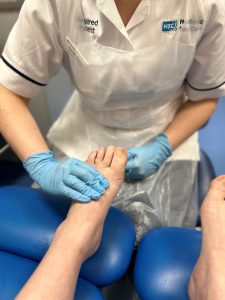 Diabetic foot disease is becoming an increasingly urgent health issue with more patients living with the disease are suffering from ulceration and amputation. The regional diabetic foot pathway launched in 2018. This pathway offers an improved service for people living with diabetes from Foot Screening, assessment, diagnosis of risk, education, protection and escalation through the Foot Protection Team (FPT), the Enhanced Foot Protection Team (EFPT) and the Multidisciplinary Foot Protection Team (MDFT).
Diabetic foot disease is becoming an increasingly urgent health issue with more patients living with the disease are suffering from ulceration and amputation. The regional diabetic foot pathway launched in 2018. This pathway offers an improved service for people living with diabetes from Foot Screening, assessment, diagnosis of risk, education, protection and escalation through the Foot Protection Team (FPT), the Enhanced Foot Protection Team (EFPT) and the Multidisciplinary Foot Protection Team (MDFT).Foot Screening – community based service for patients who live with or have recently been diagnosed with diabetes. A Podiatrist/Podiatry Assistant assesses patients and an individual care plan is agreed. Patients who are low risk will be screened every two years. Our service no longer offers a routine nail care service for those who are deemed to be low risk.
Foot Protection Team (FPT) – community based service offering assessment, treatments and education as per risk. Prevention and management of foot ulceration and they have direct access to the hospital based foot teams (EFPT)
Enhanced Foot Protection Team (EFPT) – hospital based service in Derry/ Londonderry, Omagh and Enniskillen. Patients can self-refer or are referred by any Health Care Professional with a deteriorating foot wound or red, hot swollen foot. They will get direct access to a team of professionals with the key skills necessary to assess, diagnose and initiate immediate treatment for diabetic foot disease. This team have direct access to the regional vascular and orthopaedic foot services in Belfast (MDFT)
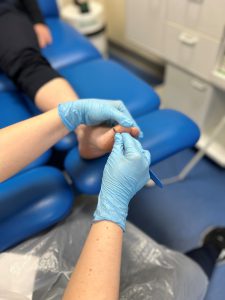 Multidisciplinary Foot Team (MDFT) – based in the Royal Victoria Hospital. This team comprises of Vascular and Orthopaedic Consultants, Interventional Radiologists, Podiatry and an Orthotist.
Multidisciplinary Foot Team (MDFT) – based in the Royal Victoria Hospital. This team comprises of Vascular and Orthopaedic Consultants, Interventional Radiologists, Podiatry and an Orthotist.This is a streamlined service available to all diabetic patients where early intervention and education can reduce the rate of ulceration and amputation. Patients are supported and encourage to manage their disease.
-
Musculoskeletal Service (MSK)
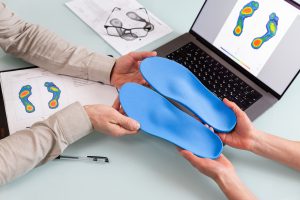 The Musculoskeltal Service treats patients with chronic and acute pain in the leg and foot, or patients with structural problems in their feet and legs that could lead to symptoms in the future. The Specialist Podiatrists will assess the way in which your legs and feet are working when you are walking and standing. This will lead to a clinical diagnosis and an individualised treatment plan which could include:
The Musculoskeltal Service treats patients with chronic and acute pain in the leg and foot, or patients with structural problems in their feet and legs that could lead to symptoms in the future. The Specialist Podiatrists will assess the way in which your legs and feet are working when you are walking and standing. This will lead to a clinical diagnosis and an individualised treatment plan which could include:- Insoles or Orthotics
- Strapping and splinting
- Stretching, Stability and Strengthening exercises
- Footwear advice

For Complex Biomechanical issues we have three specialised gait labs based in Gransha Park, Omagh Hospital and the South West Acute Hospital.
Patients can self refer or be referred by GPs, Physiotherapists and other health professionals who deem referral appropriate to the Biomechanics Service.
Patient compliance is a critical element of a successful outcome.
-
Home Visits
Western Trust Podiatry Service provide a home visiting service to patients who are totally chair or bed bound. On exceptions, a temporary home visit may be provided to patients who have experienced an acute episode of illness and clinically too ill to be expected to travel to a clinic.
The Podiatry Service encourages all patients to attend their local community clinics for a number of reasons which include being treated within a more appropriate clinical environment.
Please be assured, that by treating a patient at home, the podiatry care is no less than those who attend a clinic, it is simply that the service has limited care options when seeing a patient at home.
 Patients who are not eligible to receive a home visit include:
Patients who are not eligible to receive a home visit include:- Patients who attend other NHS appointments e.g. GP, hospital appointments.
- Patients who attend the hairdresser, shopping, post office, library.
- Patients who visit their family or friends.
- Patients who attend day centres.
The service is aware there may be situations when the patient’s circumstances are out with these criteria. In those situations, the clinician will discuss these changes with each person individually and mutually agree a decision regarding their eligibility.
-
Nail Surgery
In certain circumstances, despite conservative treatment, some toenails may require to be removed, either partially or totally.
Prior to any surgery a detailed assessment will be completed by the podiatrist to ensure that there are no contra indications to carrying out the procedure. Surgical and non-surgical options will be discussed with the patient and a treatment plan developed.
Surgery for full or partial nail removal is carried out under local anaesthetic which will be administered by the Podiatrist. The procedure normally takes about forty minutes. Comprehensive pre and post operative advice will be given by the podiatrist if surgery is required.
Normally full healing takes place in 6 –12 weeks. During this time the patient will be shown how to redress their toe and will be required to carry out redressing as required. Nails treated by our Podiatrists result in no re-growth of the nail in over 95% of cases.
Nail surgery is provided in several locations across the Trust area:
- Omagh Hospital and Primary Care Complex
- South West Acute Hospital
- Waterside Hospital
-
Children's Feet
Podopaediatrics is an area of Podiatry focusing on the diagnosis and treatment of childhood disorders of the foot and lower limb. We work in Woodview Assessment Clinic in Gransha Park.
Generally concerns regarding children’s feet and lower limbs such as flat feet, knock knees and in-toeing may not require anything other than advice and reassurance.
- Flat feet- it is natural for young children to have flat feet. As muscles begin to grow and strengthen an arch will appear. If your child has not developed an arch by the age of 9 or 10 a podiatry assessment may be advised.
- In-toeing- children who in-toe are usually otherwise healthy and although this may present some early challenges, your child can be expected to lead a normal and active life. If in-toeing persists to age 8 or 9 a podiatry assessment may be recommended.
- Knock knees- this is where the knees point inwards to face each other and usually improves after 4 years of age.
The treatment we provide can range from footwear advice and education to care for the young vulnerable foot as they grow and develop to ensure what footwear type’s parents should consider and frequency they get their child’s feet measured.
Orthotic treatment when appropriate can be issued used a range of precast devices to custom milled Cad Cam orthotic intervention with our own in house appliance centre based at Gransha allowing for orthotic adaption and manufacture at our gait lab Hub.
Stretching advice is also a key component in our education and advising on warm up/cool downs for sports to encourage good habits at an early age group into adulthood.
There may be occasions when biomechanical abnormalities require intervention. The podiatrist will provide an initial assessment, diagnosis and treatment which may include footwear evaluation and advice, foot health education and sometimes the provision of special insoles. The treatment plan may require onward referral to another service or appropriate consultant.
-
Renal Podiatry
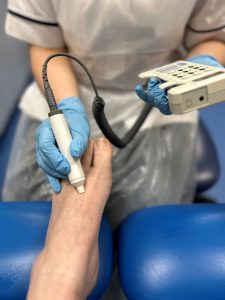 Individuals with Chronic Kidney Disease (CKD) have an increased risk for foot ulceration and lower limb loss.
Individuals with Chronic Kidney Disease (CKD) have an increased risk for foot ulceration and lower limb loss.Declining kidney function is an independent risk factor for foot ulceration and lower extremity amputation with a greater risk identified in individuals with Diabetes Mellitus (DM) and who require Haemodialysis (HD).
The Western Health and Social Care Trust Renal Podiatry service is located within Altnagelvin Area Hospital and Omagh Hospital and in particular is available to those with End Stage Renal Disease (ESRD) who receive Haemodialysis.
The Renal Podiatrist role focusses on early recognition of high-risk foot concerns with regular screening and follow up. This involves the evaluation of lower limb circulation and loss of sensation of the feet, the provision of treatment focused on relieving symptoms that enable and maintain independence, function and wellbeing, in conjunction with targeted education, and empowerment of the individual.
This service provision includes assessment and management of complications such as foot ulceration as part of a multidisciplinary team in order to help reduce foot disease related hospitalisations and amputations in individuals with chronic kidney disease.
The Renal Podiatrist also acts as a supportive resource to Podiatry colleagues and health care providers who are involved in the care of individuals with CKD.
-
Referrals
Our service accepts referrals from GPs and other health care professionals. We also accept self-referrals.
All referrals should be made using our Podiatry Referral Form.
When we receive your referral, it will be screened by a podiatrist and you may be offered an appointment for assessment.
If you are self-referring, please complete the referral form and return it to your preferred clinic location.
Download and Print the relevant Referral Form below:
- Useful Links
-
Further Resources
Taking Care of Your Feet – Patient Resource – Download and Print

Podiatry Department Foot Health Advice Leaflet
Taking Care of Your Feet – Fit Feet
- Wash your feet daily. Not too hot, too long or too soapy.
- Ensure to wipe clean between toes to prevent risk of infection.
- Moisturise feet and heels daily but not between toes.
- Cut nails straight across.
- File nails weekly.
- If your feet are sore check them for blisters, calluses, verrucae, rashes or bruises.
- Do not pick or peel at your feet.
- Apply a clean dressing on any wound or scratch.
- Red, swollen or hot toes or discoloured nails, seek advice from your podiatrist, GP or pharmacist.
- Always wear clean socks everyday.
Spot the Difference
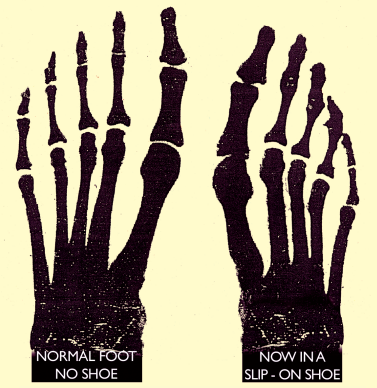
- The space between the toe joints.
- The space between the toes.
- The bones of the feet.
- The length and width of the foot.
FACT! Poor fitting footwear is the main cause of painful callus and corns. Don’t let the size of your shoes bluff you… particularly if you wear slip-ons. Laced shows need to fit your feet differently.
For further information contact your podiatrist.
A podiatrist is an Allied Health Professional (AHP) who deals with diagnosing and managing problems affecting the foot and lower limb. Degree qualified they are regulated by the HCPC to keep the public safe.
For more information contact the Podiatry Dept:
Derry/Londonderry: 028 7186 5100
Omagh: 028 8283 5005 Ext 237437
South West Acute Hospital: 028 6638 2111
Service access is through self and GP referral. It is important that all patients are registered with us for specialist foot health care.
For more information visit:
www.westerntrust.hscni.net/podiatry
www.rcopd.org.uk
Locations where this service is delivered
- Altnagelvin Area Hospital
- Community Services
- Health Centres
- Omagh Hospital and Primary Care Complex
- South West Acute Hospital
- Waterside Hospital
Contacts
Foyle Area
Omagh Hospital and Primary Care Complex
Enniskillen Area




